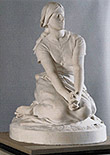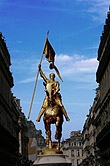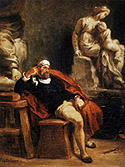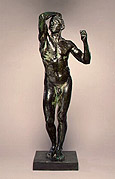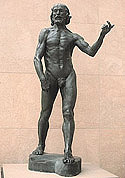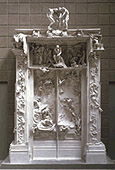The browser will either open the file, download it, or display a dialog.
|
|
"This man is Michelangelo": Octave Mirbeau, Auguste Rodin and the Image of the Modern Sculptor |
|||||||||||||||
| "I tell you, Monsieur, this man is Michelangelo and you don't know him."1 With those words a writer directly equated Auguste Rodin with Michelangelo for the first time in the press. Octave Mirbeau penned the phrase in an 1884 column for the right-wing journal Le Gaulois and would continue to style Rodin as Michelangelo for the rest of the decade. As much a promoter as he was an art journalist, Mirbeau's fundamental role in Rodin's popular acceptance as an artist has been largely understudied by art historians. While other writers, notably Gustave Geoffroy, Dargenty, and Louis de Fourcaud championed Rodin's work throughout the 1880's, Mirbeau offered the general audience a means to understand and accept Rodin's revolutionary approach to the human figure through the lens of Michelangelo. When Mirbeau evoked Michelangelo as an example of the responsive modern artist, he did nothing unusual in terms of nineteenth century rhetoric. He, like other writers before, attributed the general qualities popularly ascribed to modern art, namely: intense involvement with contemporary issues and the willingness to express one's own passions, to Michelangelo and to the painter Delacroix. He then used these artists to create a valid, coherent, and meaningful artistic heritage for Rodin. While Mirbeau and other early critics were astonished by Rodin's naturalistic approach to the human figure, Mirbeau's initial association of Rodin and Michelangelo was broadly thematic. This paper traces the history of Mirbeau's writing on the subject of Rodin as the modern Michelangelo and delineates its debt to the writings of the Romantic author Stendhal. | ||||||||||||||||
| Although best-known today as a novelist, Mirbeau emerged as an art promoter, advocate and cultural gadfly in Third Republic Paris. Working as a stockbroker and writing for conservative journals after the Franco-Prussian War, he was firmly entrenched in the ideals and politics of the monarchist camp. Eventually, the evolution of his social and political sentiments led him to anarchism, a position he espoused for the rest of his life. As his alliances and interests shifted, so did his affiliation with the various Parisian journals of the day. He began his career writing for the conservative Le Figaro, and the monarchist Le Gaulois, but would publish in progressive journals such as La Plume and La Revue blanche at the end.2 During this period of change, Mirbeau frequented the ateliers of Parisian artists, undertaking what Anne Pingeot has described as his self-education in the arts.3 | ||||||||||||||||
| In the Parisian art world Mirbeau became a remarkably effective marchand-critique.4 Not simply an art journalist, Mirbeau was a promoter touting Rodin in the press, making the sculptor's work palatable to the public, and organizing exhibitions. By the mid-nineteenth century, new art galleries and other exhibition venues had sprung up all over Paris and readers wanted art journalists and critics, like Mirbeau, to point out the extraordinary and exciting work to be found amid the more mundane examples. Mirbeau was a powerful advocate always seeking a scandal to denounce or an unknown artist to defend and promote. His friend and associate, Gustave Geoffroy, summed up the contradictions and transformations of Mirbeau when he commented, "He's a curious case. Alternatively a man of letters and a man of business. Monsieur Octave Mirbeau will end by establishing himself as a storefront prophet on the Boulevard des Capucines."5 While others may have practiced more nuanced art criticism, Mirbeau's enthusiasm and penchant for publicity brought attention to his subjects and himself. In the end, many would agree with Geoffroy that Mirbeau possessed a remarkable ability to envision the future of French art. | ||||||||||||||||
| The first meeting of Mirbeau and Rodin is undocumented, and they may not have met by 1884 when Mirbeau introduced the sculptor to the readers of Le Gaulois. Mirbeau must have known Rodin by reputation following the public controversy concerning the Age of Bronze and his subsequent commission to create the Gates of Hell for the proposed Musée des Art Décoratifs. Certainly, the two had become acquainted by the winter of 1885 when Mirbeau visited Rodin's atelier before publishing the first full description of the Gates of Hell. The two men would maintain an association throughout their lives with Mirbeau promoting the work of his sculptor until the end. | ||||||||||||||||
| When Mirbeau began to promote Rodin in the press, he faced the difficulty of making his sculpture understandable and acceptable to his readers. For the citizens of Third Republic Paris, sculpture played an important role in their everyday lives. The sculpture of major public monuments thrived in Third Republic Paris leading an unsympathetic critic to describe the impulse to commission these works as "statuomanie." All of these projects taught the general public by their example the qualities of elegance, power and decorum that sculpture should possess. Rodin's figures for all of their expressiveness would always have an uneasy relationship with these expectations. | ||||||||||||||||
| In many respects sculpture remained governed by the requirements expounded by Denis Diderot in his Salon of 1765 when he described the art's "violent, but secretive and silent muse." Diderot's recapitulation of the paragone, the debate concerning painting's superiority to sculpture, persisted in discussions concerning the nature of sculpture throughout the nineteenth century. In that Salon, Diderot argued that a painter could "paint whatever [he] wants; [but] sculpture—severe, grave, chaste must choose." So sculpture should be . . . voluptuous but never lewd. In a voluptuous mode it retains something that's refined, rarefied, exquisite, . . . Sculpture requires an enthusiasm that's more obstinate and deep-seated, more of a kind of verve that seems strong and tranquil, more of this covered, hidden fire that burns within; its muse is violent, but secretive and silent.6 | ||||||||||||||||
| The clear distinctions Diderot drew between the arts of painting and sculpture were codified in 1817 by statesman and historian François Guizot in his "Essay on the limits that separate and bonds that unite the fine arts." He, like Diderot, argued that sculpture was meant to represent emotions and actions distilled into disciplined, unified forms while painting could offer the viewer dramatic motion and activity with the verve and immediacy denied to sculpture.7 In that same year, Stendhal commented that, "Sculpture as a medium is limited to expressing physical appearances through the muscles. Thus full-size statues can only represent permanent characteristics or emotions that have become habitual." He concluded that forms could therefore be only "slightly modified" by emotions.8 | ||||||||||||||||
|
Certainly this paradigm of sculpture remained in place as late as 1884 when the critic André Michel, writing for L'Art, descended into the sculpture garden of the Salon of 1884
The outmoded thinking about sculpture expressed in Diderot's 1765 Salon and sardonically restated by André Michel in 1884 ultimately led to frustration for sculptors and critics alike. While many critics viewed the art's intransigence as a consequence of its very nature, another force motivating its conservatism was social and economic. Sculpture was above all public art and, as Jules Ferry remarked in 1879, its "principal client [was] the government."10 Illustrative of the public commissions of that period were Henri Chapu's Joan of Arc Listening to Voices, in the Musée du Luxembourg (1870-73), and Emmanuel Frémiet's heroic equestrian bronze Joan of Arc (1872-74) placed in the Place des Pyramides (figs. 1 and 2). The elegant figures are thematically and physically contained. Their closed narratives and still, concentrated forms, implying motion while manifesting stillness, clearly recall the dicta of Diderot and the demands of the traditions of official French art. The many public monuments of nineteenth-century Paris came from the hands of sculptors who acceded to these aesthetic requirements. |
|||||||||||||||
|
Diderot's description summarized some general expectations for sculpture in France, but it certainly did not go unchallenged. When Mirbeau styled Rodin as Michelangelo, there was nothing novel about the comparison or the evocation of Michelangelo as the ultimate antidote to the classicism of Raphael and the Academic approach. For example, in 1817 Stendhal published his History of Painting in Italy, called the "Koran of Romantic painters" by E.-J. Delécluze.11 The book's characterization of Michelangelo, in particular, offered readers a model for the modern, Romantic artist. Its profound impact affected artists like Eugène Delacroix who modeled himself on Michelangelo, and writers such as Émile Zola. Stendhal viewed Michelangelo as the prototype of the new artist who would express the turbulence and passion of the nineteenth century. In his book, he called for a new Michelangelo, exhorting the reader to recognize that:
Stendhal's Michelangelo learned from the Classical models of antiquity and then turned to nature as his model, creating a new art that expressed the tumult of his age. Most importantly in Stendhal's view, Michelangelo's art was entirely contingent upon the social and cultural conditions of its time. Rather than looking back, the modern artists of the nineteenth century would, like Michelangelo, reach into themselves and their world to create evocative, modern sculpture. They would take cold marble—the locus of Classical expression without peer—and compel it to express the torrent of emotion found in the literature of Shakespeare with the immediacy previously ascribed only to painting. The writer, who would later champion Romantic painters like Delacroix, could not identify his modern Michelangelo where sculpture was concerned. That artist and their sculpture existed only as a formless idea. |
||||||||||||||||
|
This interpretation of Michelangelo and the nature of modernism remained central to discussions about the future of French art. Stendhal's critical position was not new. The writer took up the Classic versus Modern debate that had been central to French art criticism since the 17th century and like others placed value on contemporaneity. By the advent of Stendhal's era, being of one's own time, as Michelangelo had been, was viewed not merely as a possible good but as a positive advantage.13 For example, Delacroix's self identification with Michelangelo was well known. Indeed he had given it physical form in Michelangelo in His Studio (1850), in which the painter's biographer Silvestre noted that Michelangelo wore a white scarf wrapped around his neck in the manner of Delacroix (fig. 3).14 In 1866, Émile Zola debated the nature of a work of art with Hippolyte Taine—then professor of art and aesthetics at the École des Beaux-Arts. Zola argued that originality, the revelation of an artist's temperament, gave a work meaning. In the modern era, "unanimity of artistic beliefs is no more," he commented, "art divides and becomes individual. It is Michelangelo raising up his giants before the Virgins of Raphael; it is Delacroix breaking the lines that M. Ingres straightens out."15 Crucially for Mirbeau, however, Stendhal's Michelangelo did not reject tradition completely but instead put it aside in favor of modernity. The link to tradition was preserved even though the style was rejected. This was critical because it permitted the expensive and conservative art of sculpture to move forward without abandoning its past. | |||||||||||||||
| In this environment, progressive sculptors had occasionally found success while others remained in obscurity or experienced condemnation. Some Salon juries were more liberal than others and over the years many styles of sculpture found a place in official exhibitions. Still, the art was expected to express the gravity, refinement and outer tranquility described by Diderot. Theoretically at least, French sculpture possessed a single unified voice. Ungainly poses, fugitive gestures, fluent modeling, and a sense of immediacy rather than timelessness—all qualities of Rodin's sculpture—were out of the mainstream. By the mid-1880s though, the mainstream was hard to detect. With the advent of the artist-run Salons all of the rules and expectations seemed up for debate. The art that had expressed the will of the French state was in disarray. In 1883 and 1884, writers expressed their frustration and dismay over the state of French sculpture. | ||||||||||||||||
| This desire for unity was ably expressed by two writers, Louis de Fourcaud and Dargenty. Reviewing the Salon of 1884 for the Gazette des Beaux-Arts, Fourcaud commented, "the division is extreme and the indecision is even worse. You see nymphs to the right, peasants to the left. The nymphs are no longer completely classic; the peasants are still not realistic. What path does one follow? One pursues truth, but no one knows what truth is right for sculpture."16 In 1883, Dargenty reviewed the 1883 Exposition Nationale for the progressive journal L'Art. He put it simply, telling his readers, "National art is dead . . . Today confusion is everywhere."17 While the state of French sculpture in general frustrated both critics, they found hope in the work of Auguste Rodin whose work they could clearly identify as modern. Dargenty and Louis de Fourcaud, among others, began to praise Rodin's resolutely truthful portrait busts and his implacably naturalistic approach to the human figure. In his work, these critics recognized French sculpture's new direction. | ||||||||||||||||
|
In his review of the Exposition Nationale of 1883, Dargenty singled out Rodin's Age of Bronze and St. John the Baptist Preaching for praise while lamenting the fate that generally awaited such figures (figs. 4 and 5). They were the work of an artist who "never went to school, never belonged to any coterie, had no master at all, he makes sculpture because one day his thought germinated in that form."18 Employing the typology of the natural, unschooled artist, Dargenty made it clear that he had recognized the artist who, like Vasari's Giotto, would lead French sculpture in a new direction. He clearly echoed Zola when he described Rodin as a sculptor who "lets himself go, [and] follows the impulses of his temperament." As a measure of their critical reception by the jury, he informed the reader that the two figures were "relegated like lepers in an isolation room, both allowed to vegetate, languish, mold in their prison, living protests but powerless against the worthless partiality of a blind jury." Although he believed that Rodin represented the new path for French sculpture, he did not anticipate success for Rodin. Ultimately the jury would "quickly turn [its] back on [Rodin], and laugh at his presumption, take pity on him and leave him to starve alone with his talent."19 While he supported Rodin, it was difficult for Dargenty to believe that sculpture would or could move forward as an art. | |||||||||||||||
| Dargenty associated Rodin with his own hero, Delacroix. For Dargenty, Delacroix remained the model of the modern artist and in 1883 was "very near to [them] still, this valiant, indomitable poet, inaccessible to weakness or discouragement, who struggled in illness, poor and alone, against the universal coalition of painters and the public."20 Rodin's struggle, in Dargenty's rhetoric, mirrored Delacroix's willingness to challenge convention. In 1885 Dargenty published Delacroix: par lui-même, and in that same year Mirbeau echoed Dargenty and associated Rodin with Delacroix. | ||||||||||||||||
| By the time Mirbeau introduced the readers of Le Gaulois to the new Michelangelo in December 1884, Dargenty's review had already appeared. Two months later in February 1885, Mirbeau's most famous article about the sculptor, "Auguste Rodin," appeared in La France, quickly following the Le Gaulois piece, and provided the first complete description of The Gates of Hell (fig 6). Mirbeau set the sculpture in context for his reader with a comparison to Ghiberti's Gates of Paradise and Dante's Divine Comedy as the source of the imagery. Identifying The Thinker at the cornice as Dante, he commented that it reminded him of Michelangelo's Penseur—the Lorenzo figure from the Medici Chapel. Despite the clear affinity between the two figures, Mirbeau did not turn to Michelangelo as a point of comparison for Rodin, choosing Delacroix instead. That spring a Delacroix exhibition was scheduled to open at the Beaux-Arts and Dargenty's own Delacroix: par lui-même would be published. The upcoming exhibition and Dargenty's own invocation of Delacroix in his 1883 Exposition Nationale review may have fired Mirbeau's rhetoric. | ||||||||||||||||
|
Mirbeau emphasized Delacroix's emotionalism and his involvement with this own time as the commonality between Rodin and Delacroix. Mirbeau quoted directly from Théophile Silvestre's 1855 biography of Delacroix noting "[o]ne can say of Rodin what Théophile Silvestre once said of Delacroix, because these two geniuses are of the same ancestry."21 In Silvestre's biography one finds the early model for Mirbeau's characterization of Rodin, ultimately rooted in the writing of Stendhal. From Stendhal, Silvestre took the bedrock notion that a modern artist would openly express the torrent of emotions that characterized the nineteenth century. Mirbeau applied that interpretation to Rodin by quoting Silvestre's writing directly in his own essay:
The link between Stendhal, Silvestre, and Mirbeau is remarkably transparent. Stendhal's modern Michelangelo would "compel sculpture to express the soul's moods" in the manner of Dante or Shakespeare while Silvestre's Delacroix "astonished the dramatist." In Stendhal's view, Michelangelo would restore passion to its rightful place and express a "torrent of new sensations and pleasures," while Delacroix, "the man of our time," was full of moral illness, betrayed expectation, sarcasm, anger and tears. The conception of both artists as modern, with the attendant implications of emotionalism and originality, had its root in Stendhal's description of Michelangelo and for Mirbeau to speak of Delacroix was to speak of Michelangelo. |
||||||||||||||||
| Mirbeau's construction of Rodin as the modern Michelangelo achieved its full form in 1889 with the Monet-Rodin exhibition organized by Mirbeau at the Galeries Georges Petit. Mirbeau wrote a catalogue essay on Monet for the show and prevailed upon his associate, the Naturalist critic Gustave Geoffroy, to reprint an essay on Rodin that had appeared in Revue des Lettres et des Arts.23 As they prepared the catalogue essays, Mirbeau wrote to Geoffroy that he had made "a rather curious observation about Michelangelo. It seems to predict Rodin . . . This paragraph that I've called your attention to might be of use."24 That paragraph was Stendhal's 1817 call for a modern Michelangelo. Geoffroy appended the paragraph as an epigraph but did not develop the theme but, when read in the context of Mirbeau's involvement, it gains significance. In this quote from Stendhal, directly referenced by Mirbeau, we uncover the fundamental basis of his concept of Michelangelo as a critical term and it is doubtful that Mirbeau had come across it serendipitously. | ||||||||||||||||
|
To clarify his position, Mirbeau expanded on the theme of Michelangelo and Rodin in L'Écho de Paris. Writing about the Monet-Rodin exhibition of June 1889, Mirbeau provided the essay on Rodin that he perhaps wanted Geoffroy to write. He told his readers explicitly, "In 1817, Stendhal had foreseen Auguste Rodin. In one of these visions of the intellectual future of the race, as happened so often for this deep mind, he clearly described this art that had not yet been born, and that he did not have the joy to see achieved in these magnificent works." He continued:
Here Rodin's sculpture emerged as the direct fulfillment of a century-long desire for a new kind of French sculpture. While he claimed that Rodin exceeded the vision of Stendhal, Mirbeau reverted to the earlier writer's rhetoric. Mirbeau, like Silvestre before him, reiterated Stendhal's definition of the modern artist . Rodin, in Mirbeau's terms, expressed "the moral illness of the century" and forced marble to "shout the supreme suffering of modern negativity" while crying the "devouring tears of the unappeased and human failings." Stendhal's modern sculptor would restore passion to its rightful place, as his Michelangelo had done, and compel the art to express strong emotion. In Stendhal's conception of Michelangelo, the artist had imbibed the Classical tradition and then grew to create a new art, just as Rodin worshipped "the eternal beauty of antique form," and "without breaking the equilibrium of the body" pushed it to express modern passions. Mirbeau's conception of Rodin as the modern Michelangelo first announced in December 1884 became crystallized and powerful by 1889. |
||||||||||||||||
|
Mirbeau's efforts paid off handsomely in the press as writers repeatedly referred to Rodin in those terms after the 1889 article. In Le Courrier du soir, one writer commented that there was no precedent for Rodin but turned to Michelangelo: "Déjà-vu," he wrote, "with Rodin that impression—that critique—does not exist, there are no antecedents to invoke, no name comes to the memory, no comparison is possible, the history of all times in all countries has no similar example in art. One large shadow emerges, Michelangelo."26 Others like Fernand Bourgeat writing in L'Entr'acte repeated the general association of Rodin and Michelangelo. "I don't need to speak about the man: he is known," he commented ". . . the public knows all about the battles that our modern Michelangelo has submitted to."27 One gauge of the success of Mirbeau's characterization of Rodin is W.C. Brownell's 1901 article "Auguste Rodin," in Scribner's. Seventeen years after Mirbeau dubbed him Michelangelo for the first time, Brownell found it necessary to comment on the phenomenon and clearly distinguish Rodin's approach to sculpture from that of his predecessor:
Brownell's comment attests to the success of Mirbeau's writing. By 1901, Brownell found it necessary to loosen the tie between the two artists first developed by Mirbeau. |
||||||||||||||||
| Curiously, unlike Brownell, Mirbeau seldom discussed Rodin's own stylistic debt to Michelangelo, which the sculptor openly acknowledged and other critics clearly recognized. Indeed Rodin's use of overall designs borrowed from Michelangelo was the subject of a recent exhibition in Florence and Philadelphia, Rodin and Michelangelo: A Study in Artistic Inspiration (1996), and need not be recapitulated here. Instead, Mirbeau chose to offer his readers an effective thematic way to understand Rodin's art and the tradition from which it sprang. In Mirbeau's writing the term Michelangelo served as a metaphor to signify the modern and to reference a distinguished sculptural lineage. When the readers of Le Gaulois first encountered the name Rodin in 1884, the sculptor could have little expectation of popular success but by 1889 he was arguably the best-known sculptor in France. In no small measure this came about because Octave Mirbeau found a way to think about Rodin that his readers could understand immediately. Rather than being the complete outsider with no distinguished artistic pedigree, as he had been for most of his career, Rodin could now be seen as the inheritor of the mantle of Michelangelo. | ||||||||||||||||
|
Unless otherwise noted the translations are by the author. 1. Octave Mirbeau, "L'Indiscretion," Le Gaulois, December 15, 1884. "Il existe dans Paris un sculpteur que vous ne connaissez pas, car il ne ressemble en rien à ceux que vous recommandez et que vous aimez. Ayant du génie, il est presque pauvre, mais, comme ceux qui sont très riches et dont on dit qu'ils ne connaissent pas leur fortune, lui ne connaît pas sa pauvreté. Jamais il n'entendit parler du Figaro; il ignore même—c'est peut-être pour cela—que vous existez…Je vous le dis, Monsieur, cet homme est Michel-Ange, et vous ne le connaissez pas." 2. The principal biography of Octave Mirbeau remains Martin Schwarz, Octave Mirbeau, vie et oeuvre (The Hague: Mouton, 1966). For a discussion of Mirbeau's political evolution, see Reg Carr, Anarchism in France: The case of Octave Mirbeau (Montreal: McGill-Queen's University Press, 1977). 3. Anne Pingeot, "Rodin et Mirbeau," in Colloque Octave Mirbeau – Actes June 1991 (Arc-et-Sâenans: Éditions du Demi-Cercle, 1994), 114. 4. Jean-Paul Bouillon, La Promenade du critique influent : Anthologie de la critique d'art en France 1850-1900 (Paris: Hazan, 1990), 302. 5. Gustave Geoffroy, La Justice, July 30, 1883. 6. Denis Diderot, Diderot on Art, vol. 1, trans. and ed. John Goodman (London and New Haven: Yale University Press, 1995), 159. 7. François Guizot, Études sur les Beaux-Arts (Paris: Didier et cie., 1852), 57. 8. Stendhal, Stendhal and the Arts, ed. and trans. David Wakefield (London: Phaidon, 1973), 55 9. André Michel, "Le Salon de 1884," L'Art, pt. 2, 1884, 31–32. "…de nous mêler un moment au peuple héroïque des statues. C'est ici, pour parler comme Diderot, le royaume de 'la Muse violente, mais silencieuse et cachée.' …son langage, fait de logique sévère et nue, astreint à des règles inflexibles et certaines, privé de toutes les séductions et de tous les à peu près charmants de la peinture…Quels acheteurs trouvera-t-il dans une société comme la nôtre, en dehors de l'État et des municipalités." 10. Patricia Mainardi, The End of the Salon: Art and the State in the Early Third Republic (Cambridge: Cambridge University Press, 1994), 142. 11. Stendhal, Stendhal and the Arts, 81. 12. Stendhal, Histoire de la peinture en Italie (Paris: P. Didot, 1817) reprint, vol. 26, Œuvres complètes, gen. eds. Victor del Litto and Ernest Abravanel (Paris: Cercle du Bibliophile, 1969), 189–91. "Depuis deux siècles une prétendue politesse proscrivait les passions fortes, et, à force de les comprimer, elles les avait anéanties: On ne les trouvait plus que dans les villages. Le dix-neuvième va leur rendre leurs droits. Si un Michel-Ange nous était donné en nos jours de lumière, où ne parviendrait-il point? Quel torrent de sensations nouvelles et de jouissances ne répandrait-il pas dans un public si bien préparé par the théâtre et les romans! Peut-être créerait-il une sculpture moderne, peut-être forcerait-il cet art à exprimer les passions, si toutefois les passions lui conviennent. Du moins Michel-Ange lui ferait-il exprimer les états de l'âme. La tête de Tancrède, après la mort de Clorinde, Imogène apprenant l'infidélité de Posthumus, la douce physionomie d'Herminie arrivant chez les bergers, les trait contractés de Macduff demandant l'histoire du meurtre de ses petits enfants, Othello après avoir tué Desdémona, le groupe de Roméo et Juliette se réveillant dans le tombeau, Ugo et Parisina écoutant leur arrêt de la bouche de Niccolo, paraîtraient sur le marbre, et l'antique tomberait au second rang." 13. Linda Nochlin, Realism (New York: Penguin, 1976), 103–4. 14. Jack J. Spector, "An Interpretation of Delacroix's Michelangelo in his Studio," Psychoanalytic Perspectives on Art, ed. Mary Mathews Gedo (Hillsdale NJ: The Analytic Press, 1985), 116. 15. Émile Zola, "M. Taine, Artiste," Mes haines: causeries littéraires et artistiques (1879; reprint, Geneva: Slatkine Reprints, 1979), 225-–26. 16. Louis de Fourcaud, "Le Salon de 1884," Gazette des Beaux Arts, 2nd ser., 30, (1884), 56. 17. Dargenty, "Le Salon National," L'Art, part 4 (1884), 36. 18. Ibid., 37. 19. Ibid. "…un artiste dans le vrai sens du mot [qui] se laisse aller, suit l'impulsion de son tempérament, s'il évite de regarder les autres, crainte de se fondre en eux; s'il conserve son intégrité, si ses qualités et ses défauts son à lui, bien à lui, si ce ne sont ni les défauts ni les qualités de l'école, s'il se présente naïvement à vous, disant: Juge-moi, je suis ce que je suis, on le tient pour un fou, on se hâte de lui tourner le dos, on rit de son outrecuidance, on le prend en pitié et on le laisse crever de faim en tète-à-tète avec son talent." 20. Dargenty, "Le Salon National," 37. 21. Octave Mirbeau, "Auguste Rodin," La France, February 18, 1885. 22. Ibid. "On peut dire de Rodin ce que Théophile Silvestre disait jadis de Delacroix à qui l'on peut comparer, car ce sont deux génies de même race: 'Ce qui fait de Delacroix un des plus grands artistes du XIXe siècle, c'est qu'il réunit les facultés du peintre, du poète et de l'historien. Il sème, avec une abondance qui étonne le dramaturge, les passions sur sa toile et dans l'âme du spectateur comme des graines funestes. Il rappelle Rembrandt par l'expression des physionomies; Véronèse par l'esprit, la finesse, le charme de la couleur; Rubens par la splendeur des décorations et la crânerie de la main; Michel-Ange par le grandiose, et Ribera par le terrible. Il séduit et emporte tour à tour les intelligences hautaines et les cœurs aventureux par l'amour du beau et de l'héroïque, par l'audace, la ruse, la force et la noblesse. Il est surtout l'homme de notre temps, plein de maladies morales, d'espérances trahies, de sarcasmes, de colères et de pleurs. L'ignorance et l'envie ne l'ont pas un instant arrêté dans sa carrière et ne prévaudront jamais contre lui devant la postérité.'" 23. Gustave Geoffroy, "Auguste Rodin," in Claude Monet – Auguste Rodin: Centenaire de l'exposition de 1889. Exh. cat. (Paris: Musée Rodin, 1989), 57. 24. Octave Mirbeau, Combats esthétiques, vol. 1, ed. Pierre Michel and Jean-François Nivet (Paris: Séguier, 1993), 386. 25. Octave Mirbeau, "Auguste Rodin," L'Écho de Paris, June 25, 1889. 26. M. D'Auray, "Chroniques—Claude Monet et Rodin," Le Courrier du Soir, June 26, 1889. 27. Fernand Bourgeat, "Chronique parisienne: A la galerie Georges Petit," L'Entr'acte, June 26, 1889; Repeated in "Paris vivant—à la galerie Georges Petit," Le Siècle, June 22, 1889. 28. W. C. Brownell, "Auguste Rodin," Scribner's Magazine 29, January–June 1901, 90–91.
|


